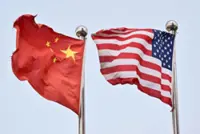Of the 15 countries that America runs the largest bilateral goods trade deficit with, nine are in Asia. — Reuters
US President Donald Trump loves tariffs and big numbers, so it’s no surprise that the first targets in his trade war have been economies that boast the biggest trade surpluses with the United States in dollar terms.
But if America’s bilateral deficits are measured as a share of trading partners’ economic output, or those that are widening rapidly, the countries with most to worry about are emerging economies in East Asia.
Many of them boast huge trade surpluses with the United States relative to the size of their economies, and these chasms have grown substantially since Trump first put his protectionist “America First” drive into gear eight years ago.
Their growth, domestic investment and local markets are all at risk if Washington slaps heavy duties on exports to the United States.
To add insult to injury, these countries are also likely to suffer significant collateral damage from a US-Sino trade war due to the increasingly close trade links forged with China since 2017.
Emerging Asia could be facing a “lose-lose” situation. Of the 15 countries that America runs the largest bilateral goods trade deficit with, nine are in Asia.
This is partly a result of the “China Plus One” strategy, which refers to US firms investing in countries with close economic ties to China rather than in China itself.
This trend has intensified considerably since Trump’s first term and the pandemic.
Emerging Asian countries’ exports to the United States as a share of their total exports have increased sharply in recent years to 18% from 11%.
At the same time, these countries’ trade ties with China have also intensified, reflected by the fact that 45% of emerging Asian nations’ combined exports are now shipped to the United States and China, according to economists at JP Morgan.
As a share of gross domestic product (GDP), South Korea’s trade surplus with the United States is more than twice as big as China’s, and Taiwan’s is nearly 10% of GDP.
Two countries that may be particularly vulnerable are Thailand and Vietnam.
Since 2017, Thailand’s trade gap with the United States has widened by 343%, while Vietnam’s has soared by 222%, according to economists at Citi.
In fact, Thailand now boasts the fifth-largest trade surplus with the United States, more than Japan or South Korea if European Union countries are grouped into one bloc.
That’s particularly remarkable given that Thailand’s surplus with the United States was only the 13th largest in 2017.
Meanwhile, Vietnam’s trade with both the United States and China has exploded in the last decade, emblematic of the deeper shifts in global flows as relations between China and the United States have deteriorated.
Almost 30% of its exports now go to the United States and 17% to China. That’s around 25% and 14% of GDP, respectively.
While Thailand and Vietnam both punch above their economic weight in global trade, neither has the economic heft to meaningfully retaliate against any incoming US tariffs.
And they both face additional risks if the US-Sino trade war truly heats up because they have benefitted from huge Chinese investment flows in recent years.
Indeed, China has been able to maintain its global market share despite shifts in US policy by adopting its own strategy, call it “US Plus One”.
Beijing’s shipments to emerging markets nearly tripled to 44% of total exports in 2023 from 16% in 2000, while China’s shipments to the United States fell from 21% to 16% of total exports, according to economists at Morgan Stanley.
As Morgan Stanley’s Jitania Kandhari wrote last week, “The rules of trade are being rewritten, but one constant remains: Asia – led by China – is still the centre of gravity.”
This may be true, but it’s still the United States calling the shots in the early stages of what could become a global trade war.
Unfortunately for emerging Asian nations, they are likely to find themselves exposed on many fronts. — Reuters
Jamie McGeever is a columnist for Reuters. The views expressed here are the writer’s own.





